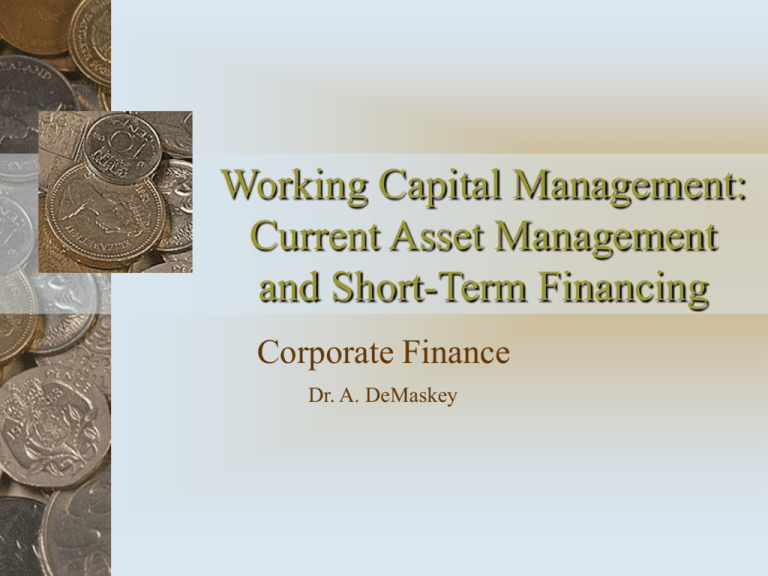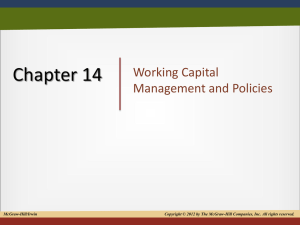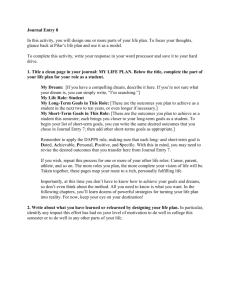Current Asset
advertisement

Working Capital Management: Current Asset Management and Short-Term Financing Corporate Finance Dr. A. DeMaskey Learning Objectives • Questions to be answered: – What is working capital management? – What is the appropriate amount of current assets for the firm to carry, both in total and for each specific account? – How should current assets be financed? – What are the major sources of short-term financing? – What are the costs associated with each type of financing? 2 Working Capital Terminology • Gross working capital – Total current assets • Net operating working capital – Current assets - Current liabilities • Working capital policy: – The level of each current asset. – How current assets are financed. (More…) 3 Working Capital Terminology • Working capital management: – Includes both establishing working capital policy and then the day-to-day control of: • • • • Cash Inventories Receivables Short-term liabilities 4 Alternative Current Asset Investment Policies Current Assets ($) Relaxed Moderate Restricted Sales ($) 5 Cash Conversion Cycle • The cash conversion cycle focuses on the time between payments made for materials and labor and payments received from sales: – Inventory conversion period – Receivables collection period – Payables deferral period 6 Goal of Cash Management • Cash is a non-earning asset. • To minimize the amount of cash in order to conduct normal business activities. • To have sufficient cash in order to: – Take trade discounts. – Maintain credit rating. – Meet unexpected cash needs. 7 Reasons for Holding Cash • Transactions balances Primary reasons • Compensating balances • Precautionary balances Secondary reasons • Speculative balances 8 Cash Budget: The Primary Cash Management Tool • Purpose: Uses forecasts of cash inflows, outflows, and ending cash balances to predict loan needs and funds available for temporary investment. • Timing: Daily, weekly, or monthly, depending upon budget’s purpose. Monthly for annual planning, daily for actual cash management. 9 Data Required for Cash Budget 1. Sales forecast. 2. Information on collections delay. 3. Forecast of purchases and payment terms. 4. Forecast of cash expenses: wages, taxes, utilities, and so on. 5. Initial cash on hand. 6. Target cash balance. 10 Ways to Minimize Cash Holdings • • • • • Use lockboxes. Insist on wire transfers from customers. Synchronize inflows and outflows. Use a remote disbursement account. Increase forecast accuracy to reduce the need for a cash “safety stock.” • Hold marketable securities instead of a cash “safety stock.” • Negotiate a line of credit (also reduces need for a “safety stock”). 11 Working Capital Financing Policies • Maturity Matching: Matches the maturity of the assets with the maturity of the financing. • Aggressive: Uses short-term (temporary) capital to finance some permanent assets. • Conservative: Uses long-term (permanent) capital to finance some temporary assets. 12 Maturity Matching Financing Policy $ Temp. C.A. S-T Loans Perm C.A. L-T Fin: Stock, Bonds, Spon. C.L. Fixed Assets Years What are “permanent” assets? 13 Aggressive Financing Policy $ Temp. C.A. S-T Loans Perm C.A. L-T Fin: Stock, Bonds, Spon. C.L. Fixed Assets Years More aggressive the lower the dashed line. 14 Conservative Financing Policy $ Marketable Securities Zero S-T debt Perm C.A. L-T Fin: Stock, Bonds, Spon. C.L. Fixed Assets Years 15 Working Capital Policy • The choice of working capital policy is a classic risk/return tradeoff. • The aggressive policy promises the highest return but carries the greatest risk. • The conservative policy has the least risk but also the lowest expected return. • The moderate (maturity matching) policy falls between the two extremes. 16 Marketable Securities • Interest-bearing short-term securities • Level of liquid assets held – Interest rate – Transaction costs – Variability in cash flows • Choosing marketable securities – – – – – Default risk Marketability or liquidity Maturity Purchasing power risk Rate of return 17 Short-Term Financing • Short-term debt is riskier than long-term debt for the borrower. – Short-term rates may rise. – May have trouble rolling debt over. • Advantages of short-term debt. – Typically lower cost. – Can get funds relatively quickly with low transactions costs. – Can repay without penalty. 18 Major Sources of Short-Term Financing • Short-term credit: Debt requiring repayment within one year. • Major sources: – – – – Accruals Accounts payable (trade credit) Bank loans Commercial paper 19 Trade Credit • Trade credit is credit furnished by a firm’s suppliers. – Free trade credit – Costly trade credit • Trade credit is often the largest source of short-term credit for small firms. • Trade credit is spontaneous and relatively easy to get, but the cost can be high. 20 Bank Loans • Mature in one year or less. • Compensating balance requirement • Types of bank loans: – Line of credit – Revolving credit agreement 21 Interest Cost of Bank Loans • • • • • Regular, or simple, interest Discount interest Add-on interest Annual percentage rate Interest rate with compensating balance requirement 22 Effective Annual Percentage Rate • To be able to compare loan cost rates and choose the alternative with the lowest cost. • Because the loans have different terms, we must make the comparison on the basis of EARs. 23 Commercial Paper • • • • Unsecured promissory note Issued by large, financially sound firms Average maturity of five months Interest rate is less than prime rate but slightly more than T-Bill rate • Commercial paper market is impersonal 24




